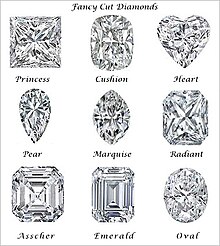While the round brilliant cut is considered standard for diamond, with its shape and proportions nearly constant, the choice of fancy cut is influenced heavily by fashion. For example, the step cut baguette—which accentuates a diamond's luster, whiteness, and clarity but downplays its fire—was all the rage during the Art Deco period, whereas the mixed Princess cut—which accentuates a diamond's fire and brilliance rather than its luster—is currently gaining popularity. The princess cut is also popular among diamond cutters: of all the cuts, it wastes the least of the original crystal. Older diamonds cut before ca. 1900 were cut in "primitive" versions of the modern round brilliant, such as the rose cut and old mine cut (see History section). Although there is a market for antique stones, many are recut into modern brilliants to increase their marketability. There is also increasing demand for diamonds to be cut in older styles for the purpose of repairing or reproducing antique jewelry.
The size of a diamond may also be a factor. Very small (< 0.02 carats [4 mg]) diamonds—known as melée—are usually given simplified cuts (i.e., with fewer facets). This is because a full-cut brilliant of such small size would appear milky to the human eye, owing to its inability to resolve the stone's dispersive fire. Conversely, very large diamonds are usually given fancy cuts with many extra facets. Conventional round brilliant or fancy cuts do not scale up satisfactorily, so the extra facets are needed to ensure there are no "dead spots". Because large diamonds are less likely to be set in jewelry, their cuts are considered for how well they display the diamonds' properties from a wide range of viewing directions; in the case of more moderate-sized diamonds, the cuts are considered primarily for their face-up appeal.
The dominating round brilliant diamonds are not as trendy as they used to be since the market was overcrowded in the last decades of the century. Simultaneously, giving a fancy diamond cut as a precious jewel on specific celebrations became a part of tradition. A Heart cut diamond has romantic symbolism so it is a common gift for Valentine's Day or wedding anniversary. The pear-shaped diamonds look like a drop of water and the shape is suitable for diamond earrings. The most famous shapes are: Princess, Cushion, Heart, Pear, Marquise, Radiant, Asscher cut, Emerald, Oval.
(Source: Wikipedia http://en.wikipedia.org/wiki/Diamond_cut ).
